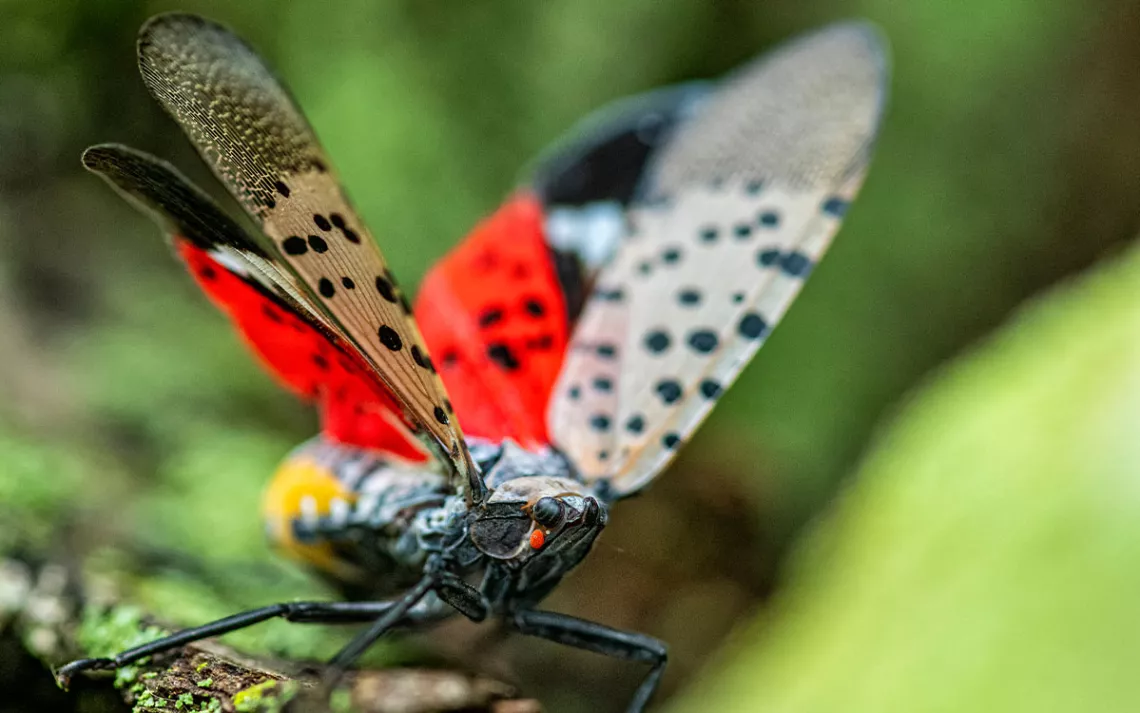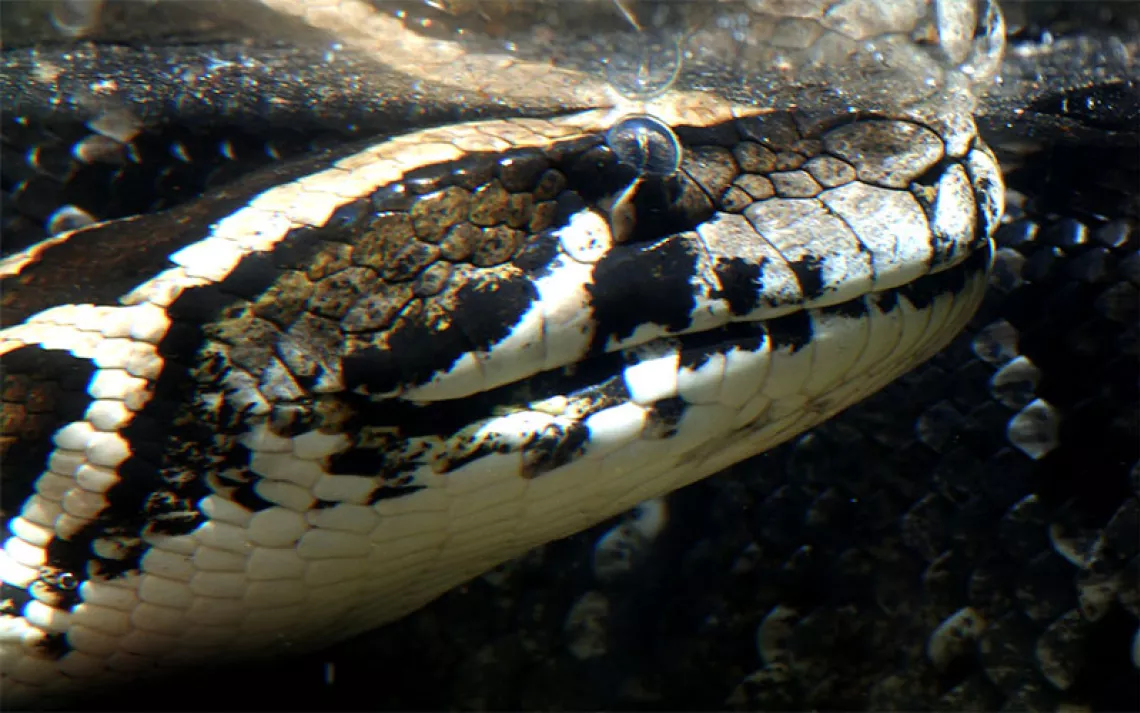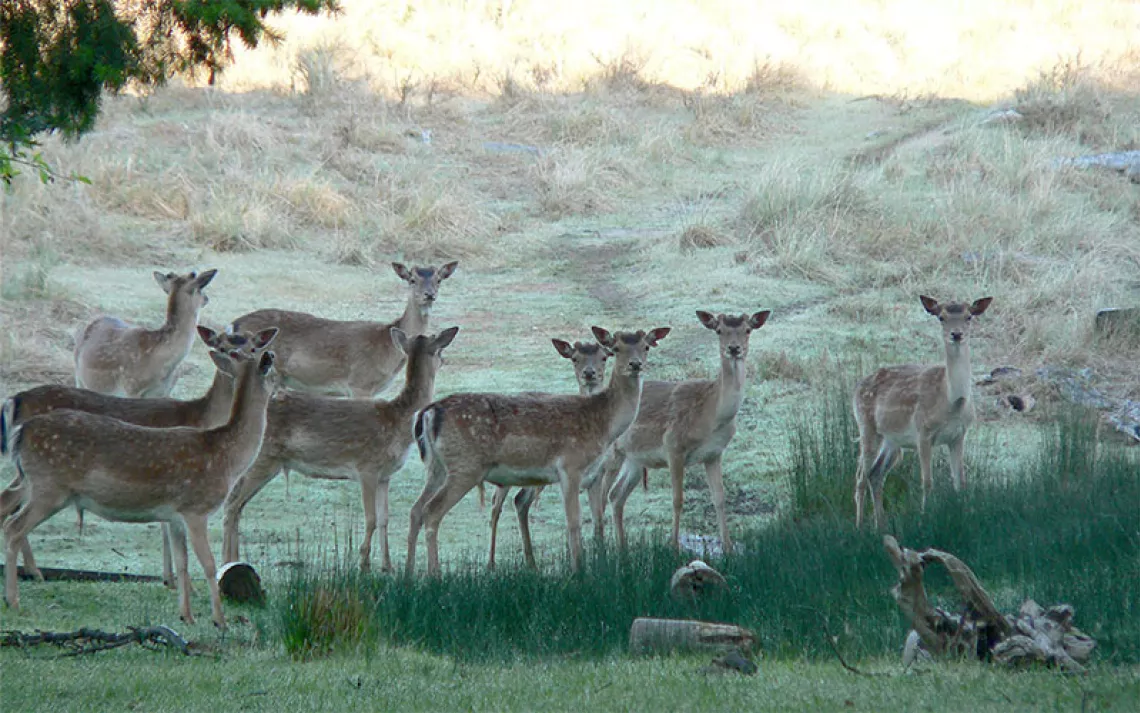How to Stop the Spread of Spotted Lanternflies
These colorful insects are moving across the Northeast and will likely be near you soon

The spotted lanternfly is an invasive insect from Asia that has made it to the mid-Atlantic area of the United States.| Photo by cmannphoto/iStock
To be confronted with a spotted lanternfly—or swarms of them—is to experience some level of cognitive dissonance. On its own, an adult lanternfly is almost an artistic creation—a butterfly-like insect with scarlet, yellow, and gray hues fluttering away upon the slightest touch. If you’re out for a walk, one might softly land on your back for a short ride to its next destination. But together, resting on a tree of heaven or on the side of a building, a swarm of lanternflies inspires the very human feeling of … ick.
In the last decade, these new arrivals have swarmed towns across the Northeast from Washington, DC, to Boston. First detected in Pennsylvania in 2014, spotted lanternflies likely arrived in shipping containers. By 2019, over 150,000 were estimated to live in the Keystone State. Now, the scarlet-winged insects, originally from China, are rapidly spreading across 14 states in the eastern US. One study predicted that lanternflies could reach the West Coast as early as 2033 without measures in place to halt their spread. State natural resource agencies and agricultural departments have implored citizens to stomp, crush, and smash them on sight. But as their populations expand, some people are starting to wonder if there’s another way to deal with their growing populations.
Winter’s coming, and the plant hoppers are now laying their egg masses, setting the stage for thousands to hatch next year. While there is the oft-covered strategy of people squashing lanternflies, scientists say there are more sophisticated ways to stop their spread rather than simply stomping them. The overall sense is that it’s going to take much more than individual action to control spotted lanternflies. The effort needs to be a targeted approach that includes ethical, less violent tactics.
“I'd like to avoid people being outside and stomping on insects,” says Anne Nielsen, an entomologist at the Agricultural Research and Extension Center at Rutgers University. “I don't think that that's a very positive message that we should be spreading. And it's honestly probably not effective.”
Before delving into what researchers are planning, it may be worth considering why some people say lanternflies are such a problem. For one, they have no natural predators in the US that regulate their population. Initial estimates of the impact of spotted lanternflies on Pennsylvania’s agricultural economy were $42.6 million, which mostly focused on the effects on nurseries and grape and Christmas tree growers. For wine grape growers, an infestation of spotted lanternflies means increased pesticide costs. A study conducted near six vineyards in New Jersey found there was an 88 percent probability of finding spotted lanternfly egg masses near wild grapevines. Years and years of spotted lanternfly infestations can also stress tree species like walnut and maple, affecting their overall quality and growth.
For homeowners, the lanternflies can be a nuisance, says Nielsen. Brightly colored and conspicuous with a tendency to congregate, spotted lanternflies leave behind a sticky honeydew, which attracts yellow jackets, ants, and bees. But things are not as bad as initially expected. Although spotted lanternflies have caused certain tree species, such as tree of heaven and grapevines to die, “we really haven’t seen widespread mortality of plant species across the 14 states spotted lanternflies are known to be in,” says Matt Travis, the spotted lanternfly national policy manager for the US Department of Agriculture. There currently isn’t enough data to determine the overall economic impact on infected states, he adds.
Government efforts to control their population fall under the jurisdiction of the Department of Agriculture, which has identified railroads, trucks, and tractor-trailers carrying goods, and ports—such as the Port of Newark and Port Authority of New York and New Jersey—as locations where the potential for spotted lanternfly to spread over long distances is highest. They can’t fly too far so they hitchhike, attaching themselves to trucks, shipments, and cars, which has led government agencies to one clear way to stop lanternfly expansion. Scientists and regulators are inspecting goods—like agricultural products, heavy boxes, and shipping containers—to eradicate spotted lanternflies and their egg masses before they reach new areas. In New Jersey, a state at the center of domestic shipping with some of the busiest interstate highways in the nation, the USDA’s efforts are targeted toward slowing the spread throughout the lifecycle of the lanternfly.
In their adult and juvenile stages, the spotted lanternflies thrive on tree of heaven, their primary host plant, which is another invasive species from China that is often found around highly disturbed sites like railroad tracks and highways. This predictable behavior has led to another effective method to control the spotted lanternfly populations—setting up circle traps around the trunks of trees. Nymphs—younger versions of the spotted lanternfly—tend to climb up and down the trees, so setting up a simple trap with a clear plastic bag that the nymphs get funneled into can be a good tactic. The New Jersey Department of Agriculture is using circle traps on trees of heaven in public areas like railroad tracks and highways. Private citizens can also set up circle traps if there are affected trees in their yards.
Before it gets too cold, adult lanternflies lay egg masses, which look like brown and scaly deposits on tree barks. Scraping the egg masses can also be highly effective, given that each egg mass could possibly hatch 30 to 50 nymphs next year. Lately, scientists are using a new trick: vacuuming up egg masses and adult lanternflies, wearing backpacks that make them look like ghostbusters. The backpack vacuums suck up the adult lanternflies and their egg masses, destroying them in the process.
Another technique involves using traditional insecticides—either directly on the nymphs or adult lanternflies or injecting an insecticide into the bark of an infected tree. This kills lanternflies who feed on any part of the tree. It’s important to be careful about the timing of this approach, says Saul Vaiciunas, plant pathologist at New Jersey’s Department of Agriculture. Insecticides should only be applied after the tree has finished blooming to avoid harming native species and honeybees who might feed on flowers. Nielsen recommends caution in spraying insecticides and contracting with a landscaper to ensure they are applied safely.
But it looks like we might be living with the lanternflies in the US, at least for a while. The spotted lanternfly is also considered invasive in South Korea, where it goes through cycles of appearance. The USDA is currently running quarantined experiments to develop some sort of biological control—a parasitoid or tiny stingless wasps—that could possibly stop the lanternflies while in the egg mass or nymph stages of their lifecycle. But there’s a lot more work to be done to make sure these forms of control only target the spotted lanternfly, and not other species.
In their defense, spotted lanternflies do not bite, do not sting, do not harm pets, do not damage homes, and are not killing native forest species or the trees in our yards. Some might argue that what science considers invasive or non-native today might in a few years, or a few decades, be beneficial, something we rely on or even considered native—like dozens of honeybee species.
Vaiciunas suggests that there are more dangerous beetles and diseases out there, such as the emerald ash borer targeting ash trees and the beach leaf disease decimating beech trees. There’s also the hemlock woolly adelgid, which threatens eastern hemlocks.
“There are more serious problems in the forest than the spotted lanternfly,” he says. “I don’t want to minimize it because it does affect people's ability to enjoy their yard … but the only plant I’ve personally seen [spotted lanternflies] kill was tree of heaven, which is an invasive weedy plant itself that no one would plant on purpose.”
This story was produced with the support of CivicStory and the New Jersey Sustainability Reporting Project.
 The Magazine of The Sierra Club
The Magazine of The Sierra Club



